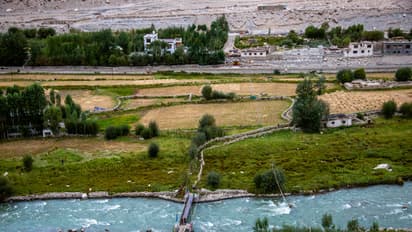Amid rising tensions, India issues formal notice to Pakistan for review & modification of Indus Water Treaty

Synopsis
Under the Indus Waters Treaty, which was signed in 1960, India is allocated all the water from the eastern rivers—Sutlej, Beas, and Ravi—totaling approximately 33 million acre-feet (MAF) annually, for unrestricted use.
India served a formal notice to Pakistan on August 30, 2024, requesting a review and modification of the Indus Waters Treaty under Article XII(3) of the Treaty, according to ANI sources. The notification from India highlights fundamental and unforeseen changes in circumstances that necessitate a reassessment of obligations under various Articles of the Treaty. With this notice, India has called on Pakistan to initiate government-to-government (G2G) negotiations to review the Treaty in accordance with Article XII(3).
This move follows a similar notice sent to Pakistan in January 2023, which sought amendments to the 1960 treaty due to Pakistan's lack of cooperation in implementing its provisions.
Under the Indus Waters Treaty, which was signed in 1960, India is allocated all the water from the eastern rivers—Sutlej, Beas, and Ravi—totaling approximately 33 million acre-feet (MAF) annually, for unrestricted use. Conversely, Pakistan receives the majority of the water from the western rivers—Indus, Jhelum, and Chenab—amounting to around 135 MAF annually.
The Indus Waters Treaty grants India the right to generate hydroelectricity through run-of-the-river projects on the western rivers, provided they meet specific design and operational criteria. Pakistan, however, has the right to raise objections to the design of these Indian hydroelectric projects.
Under the treaty, Pakistan receives approximately 80 percent of the water from the Indus drainage system, while India is allocated around 33 million acre-feet (MAF) out of the total 168 MAF. Currently, India uses slightly more than 90 percent of its allocated share of Indus waters.
India has the right to use water from the Indus River system in several states, including Ladakh, Jammu and Kashmir, Himachal Pradesh, Punjab, Haryana, and Rajasthan. These states also receive water from the Yamuna River, which is a tributary of the Ganga.
Pakistan, particularly dependent on the Indus system for its Punjab province, which is essential for the country's agricultural needs, often raises objections whenever India utilizes its allocated water quota or undertakes dam construction. These disputes have contributed to ongoing tensions between the two nations.
One notable example is the Tulbul Navigation Project, which the Indian government decided to accelerate in response to the Uri terror attack. Known as the Wullar Barrage project in Pakistan, it is a long-standing initiative that was put on hold in 1987 due to objections from Pakistan.
Despite India's repeated attempts to resolve the issue, Pakistan refused to engage in discussions during the five meetings of the Permanent Indus Commission held between 2017 and 2022. Recently, at Pakistan's persistent urging, the World Bank has initiated proceedings through both the neutral expert and Court of Arbitration processes.
Under the Indus Waters Treaty, India has the right to develop 1.34 million acres of irrigation in Jammu and Kashmir, and Ladakh. However, only 642,000 acres are currently irrigated in these Union Territories. Additionally, the treaty permits India to store up to 3.60 million acre-feet of water from the western rivers—Jhelum, Indus, and Chenab.
To date, there has been minimal development of storage capacity in Jammu and Kashmir. The treaty also allows India to construct run-of-river dams on the Jhelum, Chenab, and Indus rivers without obstructing the flow of water. This provision enables India to temporarily restrict the flow of waters allocated to Pakistan under the treaty.
Stay updated with the Breaking News Today and Latest News from across India and around the world. Get real-time updates, in-depth analysis, and comprehensive coverage of India News, World News, Indian Defence News, Kerala News, and Karnataka News. From politics to current affairs, follow every major story as it unfolds. Get real-time updates from IMD on major cities weather forecasts, including Rain alerts, Cyclone warnings, and temperature trends. Download the Asianet News Official App from the Android Play Store and iPhone App Store for accurate and timely news updates anytime, anywhere.